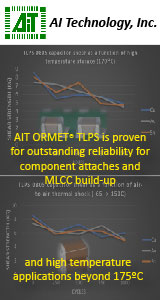|

|
|
| Ask the Experts | |||||||
|
|||||||
|
May 6, 2025 - Updated October 21, 2014 - Originally Posted Hand Soldering at Low TemperatureWe often need to make repairs in the field involving circuit board soldering. Is there any impact on a hand soldered circuit boards during winter where the circuit board and atmosphere are at 0 degrees C and humidity at 10%? P.S. |
|||||||
| Expert Panel Responses | |||||||
|
As long as you get the temperature up to the melting point and keep it there while the solder/flux does its job, you should be fine. The main concern I would have is that the solder joint would most likely cool extremely rapidly and that could cause some issues. I would find a way to warm the area as much as possible during any repairs and do a very thorough job inspecting any solder joints created in that environment.
Manufacturing Engineer Esterline Interface Technologies Mr. Hughes has been in the electronics manufacturing field for 20 years. Operating the processes and as a manufacturing engineer for the last 14 years. He is also a CIT as well as an SMTA Certified Process Engineer.
Kind of provides a new definition of cold solder joint. Two things would concern me with these conditions, thermal shock, and ESD due to the low humidity conditions. Any preheat that can be applied would help in the reducing the thermal shock to the component and the board. A larger mass soldering tool may be necessary to certify enough thermal energy is provided to the joint being worked upon. As for the ESD, verify proper grounding is sufficient to not destroy the component. I would also suggest an alternative option is to have enough spare parts so the fix can be taken care of by switching the product, then sending the defective product to the repair center for corrective action. I'm sure there is more to this process than what I've covered, but these are the quick things to take care of in the repair of these boards.
Vice President, Technical Director EPTAC Corporation At EPTAC Corporation, Mr. Lambert oversees content of course offerings, IPC Certification programs and provides customers with expert consultation in electronics manufacturing, including RoHS/WEEE and lead free issues. Leo is also the IPC General Chairman for the Assembly/Joining Process Committee.
First, let's look at the impact on the "delta-T," or the temperature difference between the board and the soldering tip. Most hand soldering operations are carried out with tip temperatures of at least 350°C. With our board initially at 0 degrees C, the delta-T is 350-0=350°C. If the board temperature is at "room temperature" of 20°C, the delta-T is 350-20=330°C. So the delta-T is increased by only 6%. Soldering time may be slightly longer to get good flow, but should not be impacted dramatically unless soldering is done without protection from strong wind. From this analysis, we would not expect the temperature difference alone to be problematic. There is one other consideration, however. The moisture content of the circuit board may be of concern if the board has been exposed to high humidity for a long period of time, and if the PWB material and/or construction make it susceptible to high moisture uptake. Laminate materials like polyimides are especially susceptible. Thicker boards with higher layer counts are more susceptible to damage as well. You would need to determine the level of susceptibility for your specific boards, so it is not possible to say whether moisture is an issue.
Process Engineer Astronautics Fritz's career in electronics manufacturing has included diverse engineering roles including PWB fabrication, thick film print & fire, SMT and wave/selective solder process engineering, and electronics materials development and marketing. Fritz's educational background is in mechanical engineering with an emphasis on materials science. Design of Experiments (DoE) techniques have been an area of independent study. Fritz has published over a dozen papers at various industry conferences.
Anytime you are soldering a PWB there is a risk to both the parts and the circuit card. A lot would depend on the material and the components. Can I get some additional info such as material, layers, 10% humidity is not to bad but most material absorb moisture quickly and maintain it. Concerns would be excessive heat causing measling, or internal delamination.
Electronics Engineer Corporate PWB BDE Boeing Research and Development 35 years in the electronics industry in design and fabrication of rigid, rigid flex and flexible pwbs. Corporate SME (DBE)on pwb design, fab and assembly.
|
|||||||
| Submit A Comment | |||||||
|
Comments are reviewed prior to posting. You must include your full name to have your comments posted. We will not post your email address. |
|
Free Newsletter Subscription
Circuitnet is built for professionals who bear the responsibility of looking ahead, imagining the future, and preparing for it. Insert Your Email Address |
|

|





